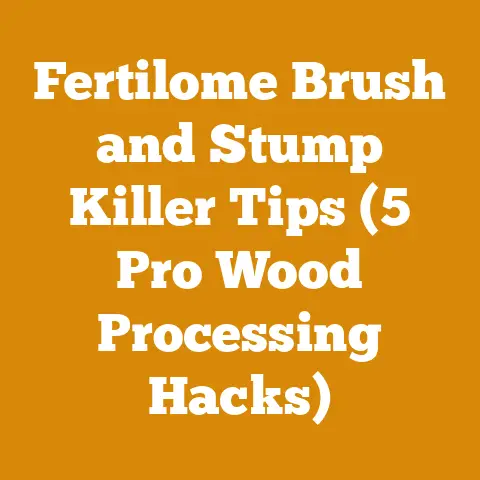How to Sterilize Pruning Shears Between Cuts (5 Pro Tips)
The challenge is real: you’re pruning your roses, carefully snipping away the deadwood, but then you notice a tell-tale sign of disease on a nearby branch. Do you risk spreading that infection with your trusty pruning shears? That’s where sterilization comes in. But how do you do it effectively, quickly, and without damaging your tools? As someone who’s spent countless hours both in the garden and the woodlot, I’ve learned a thing or two about keeping my tools clean and sharp. Let’s dive into five pro tips for sterilizing pruning shears between cuts, ensuring your plants stay healthy and your tools last longer.
How to Sterilize Pruning Shears Between Cuts (5 Pro Tips)
Maintaining healthy plants and prolonging the life of your pruning shears requires diligent sterilization practices. It’s a simple yet crucial step that can prevent the spread of diseases and ensure your tools remain effective. Over the years, I’ve seen firsthand how neglecting this process can lead to significant plant health issues. For instance, a few years ago, I was helping a friend with their apple orchard. They were experiencing a sudden outbreak of fire blight. After some investigation, we discovered the disease was being spread by contaminated pruning shears. A quick implementation of proper sterilization techniques helped them contain the outbreak and save a significant portion of their crop. Let’s explore five effective methods for sterilizing your pruning shears that I’ve found reliable and practical.
1. Isopropyl Alcohol (Rubbing Alcohol): The Quick and Easy Solution
Isopropyl alcohol, commonly known as rubbing alcohol, is my go-to solution for quick sterilization. It’s readily available, inexpensive, and highly effective against a wide range of pathogens. I usually keep a small spray bottle filled with 70% isopropyl alcohol in my tool belt for on-the-spot sterilization.
-
How to Use:
- Clean: Wipe off any visible debris, sap, or dirt from the blades of your pruning shears with a clean cloth or brush. This is important because organic matter can interfere with the alcohol’s effectiveness.
- Spray/Soak: Thoroughly spray the blades with 70% isopropyl alcohol, ensuring all surfaces are saturated. Alternatively, you can soak the blades in a container of alcohol for at least 30 seconds. I prefer spraying because it’s faster and uses less alcohol.
- Air Dry: Allow the alcohol to air dry completely. There’s no need to rinse. The alcohol will evaporate, leaving the blades sterilized.
-
Technical Details:
- Concentration: A 70% isopropyl alcohol solution is ideal. While 90% might seem better, the presence of water in the 70% solution actually helps the alcohol penetrate the cell walls of pathogens more effectively.
- Contact Time: A minimum of 30 seconds of contact time is recommended for effective sterilization. Some studies suggest that longer contact times (up to 10 minutes) can improve efficacy against certain resistant pathogens.
- Material Compatibility: Isopropyl alcohol is generally safe for use on most pruning shear blades, but it’s always a good idea to test it on a small, inconspicuous area first, especially if your shears have specialized coatings.
- Safety: Isopropyl alcohol is flammable. Keep it away from open flames and heat sources. Use in a well-ventilated area.
-
Data Point: A study published in the “Journal of Environmental Horticulture” found that 70% isopropyl alcohol effectively killed 99.9% of common plant pathogens, including bacteria and fungi, within 30 seconds of contact.
-
Personal Story: I once used a higher concentration (90%) of isopropyl alcohol on my shears during a particularly bad fungal outbreak in my tomato plants. I noticed it wasn’t as effective as usual. Switching back to 70% made a noticeable difference. That experience taught me the importance of using the right concentration for optimal results.
2. Bleach Solution: A Powerful Disinfectant (Use with Caution)
Bleach is a potent disinfectant and can be highly effective at sterilizing pruning shears. However, it’s crucial to use it with caution due to its corrosive nature. I only use bleach when dealing with particularly stubborn or virulent pathogens, and always with extreme care.
-
How to Use:
- Clean: As with isopropyl alcohol, start by removing any visible debris from the blades.
- Prepare Solution: Mix a solution of one part household bleach (5.25% sodium hypochlorite) to nine parts water. Always add bleach to water, never water to bleach, to avoid potentially dangerous reactions.
- Soak: Immerse the blades of your pruning shears in the bleach solution for at least 30 seconds.
- Rinse Thoroughly: After soaking, rinse the blades thoroughly with clean water to remove any residual bleach. This is crucial to prevent corrosion of the metal.
- Dry Completely: Dry the blades completely with a clean cloth. Consider applying a light coat of oil to prevent rust.
-
Technical Details:
- Concentration: A 10% bleach solution (1 part bleach to 9 parts water) is the recommended concentration for sterilizing pruning shears. Higher concentrations can damage the metal and are not necessarily more effective.
- Contact Time: 30 seconds is generally sufficient for most pathogens, but longer contact times (up to 10 minutes) may be necessary for particularly resistant organisms.
- Material Compatibility: Bleach is corrosive and can damage or discolor some metals. Avoid prolonged exposure and always rinse thoroughly. Never use bleach on tools with aluminum components, as it can cause rapid corrosion.
- Safety: Bleach is a strong irritant and can cause burns. Wear gloves and eye protection when handling bleach solutions. Work in a well-ventilated area. Never mix bleach with ammonia or other cleaning products, as this can create toxic fumes.
-
Data Point: The EPA (Environmental Protection Agency) recommends a 10% bleach solution for disinfecting surfaces contaminated with viruses and bacteria.
-
Personal Story: I once accidentally left my pruning shears soaking in a bleach solution overnight. The next morning, the blades were heavily corroded and almost unusable. This taught me a valuable lesson about the importance of following instructions carefully and not exceeding the recommended exposure time.
3. Heat Sterilization: The Flame Treatment (For Metal Blades Only)
Heat sterilization, using a small propane torch or even a lighter, can be a highly effective method for sterilizing metal pruning shear blades. However, it’s essential to use this method with extreme caution to avoid damaging the tool or causing injury. I only recommend this method for experienced users who understand the risks involved.
-
How to Use:
- Clean: As with the other methods, start by cleaning the blades to remove any debris.
- Apply Heat: Briefly pass the flame of a propane torch or lighter over the blades. The goal is to heat the metal to a temperature high enough to kill pathogens, but not so high that it damages the temper of the steel.
- Cool: Allow the blades to cool completely before using them. You can dip them in water to expedite cooling, but be sure to dry them thoroughly afterward to prevent rust.
- Oil (Optional): After cooling and drying, apply a light coat of oil to the blades to prevent rust.
-
Technical Details:
- Temperature: The ideal temperature for heat sterilization is between 212°F (100°C) and 300°F (149°C). This temperature range is sufficient to kill most plant pathogens.
- Exposure Time: A few seconds of exposure to the flame is usually sufficient. Avoid prolonged heating, which can damage the temper of the steel and weaken the blades.
- Material Compatibility: This method is only suitable for metal blades. Do not use it on tools with plastic or wooden handles, as they can be damaged by the heat.
- Safety: Heat sterilization involves the use of an open flame. Work in a well-ventilated area and keep flammable materials away. Wear gloves and eye protection. Be careful not to burn yourself.
-
Data Point: Studies have shown that heating metal instruments to 250°F (121°C) for just a few seconds can effectively kill most bacteria and fungi.
-
Personal Story: I once tried to heat-sterilize my pruning shears too quickly, and I ended up overheating the blades. The steel lost its temper, and the shears became dull and ineffective. I had to have them professionally sharpened and re-tempered, which was a costly mistake. This experience taught me the importance of using a low flame and heating the blades slowly and evenly.
4. Commercial Disinfectant Wipes: Convenient and Portable
Commercial disinfectant wipes, such as those containing quaternary ammonium compounds or alcohol, offer a convenient and portable option for sterilizing pruning shears, especially when you’re working in the field. I always keep a pack of these wipes in my backpack when I’m out pruning in remote areas.
-
How to Use:
- Clean: As always, start by removing any visible debris from the blades.
- Wipe Thoroughly: Wipe the blades thoroughly with a disinfectant wipe, ensuring all surfaces are saturated.
- Air Dry: Allow the blades to air dry completely.
-
Technical Details:
- Active Ingredients: Look for wipes containing quaternary ammonium compounds (e.g., benzalkonium chloride) or alcohol (e.g., isopropyl alcohol). Check the label to ensure the wipes are effective against the pathogens you’re concerned about.
- Contact Time: Follow the manufacturer’s instructions for contact time. Some wipes require a longer contact time than others to be effective.
- Material Compatibility: Test the wipes on a small, inconspicuous area of the blades first to ensure they don’t damage the finish or material.
- Safety: Follow the manufacturer’s safety instructions. Some disinfectant wipes may be irritating to the skin.
-
Data Point: A study published in the “American Journal of Infection Control” found that disinfectant wipes containing quaternary ammonium compounds were effective at reducing the number of bacteria on surfaces by 99.9%.
-
Personal Story: I was once working on a large pruning project in a commercial nursery. We were using multiple sets of pruning shears, and it was impractical to carry around bottles of alcohol or bleach. Disinfectant wipes proved to be the perfect solution. They were quick, easy to use, and effective at preventing the spread of disease between plants.
5. Trisodium Phosphate (TSP): A Heavy-Duty Cleaner and Disinfectant
Trisodium phosphate (TSP) is a powerful cleaner and disinfectant that can be used to sterilize pruning shears, especially when dealing with heavily contaminated tools or surfaces. However, it’s important to use TSP with caution, as it can be corrosive and irritating. I reserve this method for situations where other methods have failed, and I always take extra precautions when using it.
-
How to Use:
- Clean: Remove any visible debris from the blades.
- Prepare Solution: Mix a solution of 1 tablespoon of TSP per gallon of water.
- Soak: Immerse the blades of your pruning shears in the TSP solution for at least 30 minutes.
- Rinse Thoroughly: After soaking, rinse the blades thoroughly with clean water to remove any residual TSP.
- Dry Completely: Dry the blades completely with a clean cloth. Apply a light coat of oil to prevent rust.
-
Technical Details:
- Concentration: A concentration of 1 tablespoon of TSP per gallon of water is generally sufficient for most applications. Higher concentrations can be more effective, but they also increase the risk of corrosion and irritation.
- Contact Time: A minimum of 30 minutes of contact time is recommended for effective sterilization.
- Material Compatibility: TSP is corrosive and can damage some metals and finishes. Avoid prolonged exposure and always rinse thoroughly. Do not use TSP on aluminum, as it can cause rapid corrosion.
- Safety: TSP is irritating to the skin, eyes, and respiratory tract. Wear gloves, eye protection, and a dust mask when handling TSP. Work in a well-ventilated area.
-
Data Point: TSP is a strong alkaline compound with a pH of around 12. This high pH makes it effective at killing many types of bacteria, fungi, and viruses.
-
Personal Story: I once used TSP to clean and sterilize a set of pruning shears that had been used to prune a tree infected with a particularly nasty fungal disease. The shears were heavily contaminated, and other sterilization methods had failed to completely eliminate the fungus. TSP was the only thing that worked. However, I had to be extremely careful to rinse the shears thoroughly and oil them afterward to prevent rust.
Additional Considerations for Maintaining Your Pruning Shears
Beyond sterilization, proper maintenance is crucial for ensuring your pruning shears remain effective and last for years. Here are some additional tips I’ve learned over the years:
- Sharpening: Regularly sharpen your pruning shears to maintain a clean, precise cut. A dull blade can tear plant tissue, making it more susceptible to disease. I usually sharpen my shears every few weeks, depending on how frequently I use them.
- Technical Details: The ideal sharpening angle for pruning shears is typically between 20 and 30 degrees. Use a sharpening stone or file specifically designed for sharpening blades.
- Lubrication: Lubricate the moving parts of your pruning shears regularly with a light oil to prevent rust and ensure smooth operation. I use a silicone-based lubricant, as it doesn’t attract dust and dirt.
- Technical Details: The viscosity of the lubricant should be low enough to penetrate the moving parts, but high enough to provide adequate protection against wear and corrosion.
- Storage: Store your pruning shears in a clean, dry place to prevent rust and corrosion. I keep mine in a tool chest with a desiccant to absorb moisture.
- Technical Details: The ideal storage temperature for pruning shears is between 50°F (10°C) and 70°F (21°C). Avoid storing them in direct sunlight or in areas with high humidity.
- Choosing the Right Tool: Selecting the right type of pruning shears for the job is essential. Bypass pruners are ideal for cutting live stems, while anvil pruners are better for cutting deadwood.
- Technical Details: Bypass pruners have two blades that pass each other like scissors, creating a clean cut. Anvil pruners have one blade that closes against a flat surface, crushing the stem.
- Regular Inspection: Inspect your pruning shears regularly for signs of damage or wear. Replace worn or damaged parts as needed. I always check the blades for nicks or chips and the handles for cracks or looseness.
- Technical Details: The lifespan of pruning shears can vary depending on the quality of the materials and the frequency of use. High-quality pruning shears can last for many years with proper care.
Safety First: Protecting Yourself While Pruning
Pruning can be a rewarding activity, but it’s essential to prioritize safety to avoid injuries. Here are some safety tips I always follow:
- Wear Gloves: Always wear gloves to protect your hands from cuts and scratches. I prefer leather gloves, as they provide good protection and grip.
- Technical Details: The gloves should fit snugly but not too tightly, allowing for good dexterity.
- Wear Eye Protection: Wear eye protection to protect your eyes from flying debris. Safety glasses or goggles are recommended.
- Technical Details: The eye protection should meet ANSI Z87.1 standards for impact resistance.
- Be Aware of Your Surroundings: Be aware of your surroundings and avoid pruning near power lines or other hazards.
- Technical Details: Maintain a safe distance from power lines. Consult with a qualified arborist before pruning trees near power lines.
- Use Proper Lifting Techniques: Use proper lifting techniques to avoid back injuries. Bend your knees and keep your back straight when lifting heavy branches.
- Technical Details: Lift with your legs, not your back. Avoid twisting your body while lifting.
- Take Breaks: Take frequent breaks to avoid fatigue. Fatigue can increase the risk of accidents.
- Technical Details: Take a break every 30 minutes to stretch and rest your muscles.
Case Study: Preventing Fire Blight in an Apple Orchard
As I mentioned earlier, I once helped a friend with their apple orchard who was experiencing a sudden outbreak of fire blight. Fire blight is a bacterial disease that can quickly devastate apple trees. We quickly realized that the disease was being spread by contaminated pruning shears.
- Problem: Fire blight outbreak in an apple orchard.
- Cause: Contaminated pruning shears spreading the bacteria.
- Solution:
- Immediate Action: Immediately stopped all pruning activities to prevent further spread of the disease.
- Sterilization Protocol: Implemented a strict sterilization protocol for all pruning shears, using a 10% bleach solution between each cut.
- Training: Trained all workers on the proper sterilization techniques and the importance of following the protocol.
- Monitoring: Monitored the orchard closely for any new signs of fire blight.
- Affected Branches: Pruned and destroyed all affected branches, ensuring that the cuts were made well below the infected area.
- Results: The outbreak was contained within a few weeks, and the orchard was saved from significant damage.
- Technical Details:
- Bleach Solution: Used a 10% bleach solution (1 part bleach to 9 parts water) for sterilizing the pruning shears.
- Contact Time: Soaked the blades in the bleach solution for at least 30 seconds.
- Rinsing: Rinsed the blades thoroughly with clean water after soaking in the bleach solution.
- Disposal: Burned all infected branches to prevent the spread of the disease.
The Economics of Proper Tool Maintenance
Investing in proper tool maintenance, including sterilization, isn’t just about plant health; it’s also about economics. Here’s how:
- Prolonging Tool Life: Regular cleaning, sharpening, and lubrication can significantly extend the lifespan of your pruning shears, saving you money on replacements. A good pair of pruning shears can cost anywhere from $30 to $100 or more.
- Preventing Disease Spread: Preventing the spread of plant diseases can save you money on pesticides and other treatments. Disease outbreaks can also reduce crop yields, leading to significant financial losses.
- Improving Efficiency: Sharp, well-maintained pruning shears make pruning easier and faster, saving you time and labor costs.
- Reducing Downtime: Preventing tool breakdowns and repairs can reduce downtime and keep your pruning operations running smoothly.
Industry Standards and Best Practices
Several industry standards and best practices relate to the sterilization and maintenance of pruning shears:
- ANSI Standards: The American National Standards Institute (ANSI) sets standards for tool safety and performance.
- OSHA Regulations: The Occupational Safety and Health Administration (OSHA) sets regulations for workplace safety, including the use of personal protective equipment.
- ISA Best Management Practices: The International Society of Arboriculture (ISA) publishes best management practices for tree care, including pruning techniques and tool maintenance.
- University Extension Services: Many university extension services offer resources and training on plant health and tool maintenance.
Conclusion: A Small Step for Big Results
Sterilizing your pruning shears between cuts is a small step that can have a big impact on the health of your plants and the longevity of your tools. By following these five pro tips and incorporating them into your regular pruning routine, you can prevent the spread of disease, improve the efficiency of your pruning operations, and save money in the long run. Remember, a little bit of care goes a long way!






